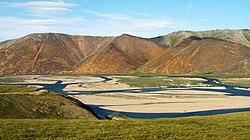| Palyavaam Russian: Паляваам | |
|---|---|
 View of the Palyavaam River | |
Location of the mouth in the Chukotka Autonomous Okrug, Russia | |
| Location | |
| Country | Russia |
| Federal subject | Chukotka Autonomous Okrug |
| Physical characteristics | |
| Source | |
| • location | Palyavaam Range |
| • coordinates | 68°0′34″N 177°41′51″E / 68.00944°N 177.69750°E |
| • elevation | 512 m (1,680 ft) |
| Mouth | |
• location | Chaun |
• coordinates | 68°43′04″N 170°49′41″E / 68.7178°N 170.8281°E |
• elevation | 0 m (0 ft) |
| Length | 416 km (258 mi) |
| Basin size | 12,900 km2 (5,000 sq mi) |
| Basin features | |
| Progression | Chaun→ East Siberian Sea |
The Palyavaam (Russian: Паляваам) is a river in the Chukotka Autonomous Okrug, Russian Far East. It is 416 kilometres (258 mi) long, and has a drainage basin of 12,900 square kilometres (5,000 sq mi).[1]
There is a small populated place in its basin also called Palyavaam. The Humpback whitefish, the East Siberian Grayling, Pink salmon, Chum salmon and Arctic char, are some of the fish species found in its waters.
Course
[edit]It has its source in the Palyavaam Range of the Chukotka Mountains. The Palyavaam flows in a roughly westward direction and passes through the sparsely populated areas of Chukotka. Finally it flows into the Chaun close to its outflow into the East Siberian Sea,[1] at the Chaunskaya Bay near Rytkuchi.
The Palyavaam has numerous tributaries. The most important ones are the Elkakvun, Palyarynnat, Karpungveyem, Levtuttyveyem, Kookvyn, Vykvylvegyrgyn and Pekychyn.
 |
 |
See also
[edit]References
[edit]- ^ a b "Река Паляваам (Каленмываам) in the State Water Register of Russia". textual.ru (in Russian).
External links
[edit] Media related to Palyavaam River at Wikimedia Commons
Media related to Palyavaam River at Wikimedia Commons- "River description & location" (PDF). (571 KB)
- Tourism and environment

Well, that’s interesting to know that Psilotum nudum are known as whisk ferns. Psilotum nudum is the commoner species of the two. While the P. flaccidum is a rare species and is found in the tropical islands. Both the species are usually epiphytic in habit and grow upon tree ferns. These species may also be terrestrial and grow in humus or in the crevices of the rocks.
View the detailed Guide of Psilotum nudum: Detailed Study Of Psilotum Nudum (Whisk Fern), Classification, Anatomy, Reproduction